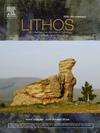Trace elements in igneous apatite: A case study of redox tracers in felsic plutons
IF 2.9
2区 地球科学
Q2 GEOCHEMISTRY & GEOPHYSICS
引用次数: 0
Abstract
Apatite, a common accessory mineral in igneous rocks, can incorporate various trace elements, making it a powerful petrogenetic indicator. The abundances of redox-sensitive elements in apatite offer a valuable probe for assessing magmatic oxygen fugacity (fO2). Previous studies have explored the dependence of S, V, Mn, Fe, As, and Eu concentrations in apatite on magmatic fO2. While the use of S in apatite as a redox proxy is well-established, the reliability of other elements for estimating magmatic fO2 remains controversial.
In this study, we present new geochemical data for apatite grains separated from Miocene granitoids in Japan, analyzed using laser ablation-inductively coupled plasma-tandem mass spectrometry (LA-ICP-MS/MS). Based on the iron content in plagioclase, the analyzed plutons are classified into oxidized and reduced types. Apatites crystallized in oxidized magmas are enriched in S (> 80 μg/g) and V (> 6 μg/g), whereas those in reduced magmas had low S (< 80 μg/g) and V (< 5 μg/g) contents, irrespective of their crystallization timing within the magma. This enrichment clearly reflects the fO2 of their parental magmas. Conversely, the Mn and Fe contents of apatite crystallized in oxidized magmas overlap with those in reduced magmas. The apparent partition coefficients of Mn and Fe between apatite and melt are strongly correlated with the ratio of non-bridging oxygen to tetrahedrally coordinated cations in the host rocks, rather than with fO2. Thus, Mn and Fe contents in apatite do not record magmatic fO2. The As content in apatite from oxidized magmas is generally higher (typically >1 μg/g) than that in apatite from reduced magmas; however, some overlaps exist between the two types. As a result, arsenic in apatite is not a reliable oxybarometer for reasons that remain unclear. Based on our dataset, only sulfur and vanadium in apatite record magmatic ƒO2.

火成岩磷灰石中的微量元素:以长英质岩体中的氧化还原示踪剂为例
磷灰石是火成岩中常见的副矿物,能结合多种微量元素,是一种强有力的成岩指示物。磷灰石中氧化还原敏感元素的丰度为评估岩浆氧逸度(fO2)提供了有价值的探针。前人的研究已经探索了磷灰石中S、V、Mn、Fe、As和Eu浓度对岩浆fO2的依赖性。虽然使用磷灰石中的S作为氧化还原代理已得到证实,但其他元素用于估算岩浆fO2的可靠性仍存在争议。本文利用激光烧蚀-电感耦合等离子体串联质谱(LA-ICP-MS/MS)对日本中新世花岗岩中分离的磷灰石颗粒进行了地球化学分析。根据斜长石中铁的含量,将分析得到的岩体分为氧化型和还原型。在氧化岩浆中结晶的磷灰石富集于S (>;80 μg/g)和V (>;6 μg/g),还原岩浆中S (<;80 μg/g)和V (<;5 μg/g)含量,与岩浆结晶时间无关。这种富集明显反映了母岩浆的fO2。相反,氧化岩浆中磷灰石的Mn和Fe含量与还原岩浆中磷灰石的Mn和Fe含量重叠。磷灰石与熔体之间Mn和Fe的表观配分系数与寄主岩石中非桥氧与四面体配位阳离子的比例密切相关,而与fO2无关。因此,磷灰石中Mn和Fe的含量不记录岩浆的fO2。氧化岩浆磷灰石中砷含量普遍高于还原岩浆磷灰石(1 μg/g);然而,这两种类型之间存在一些重叠。因此,磷灰石中的砷不是可靠的氧晴雨表,原因尚不清楚。根据我们的数据,只有磷灰石中的硫和钒记录岩浆ƒO2。
本文章由计算机程序翻译,如有差异,请以英文原文为准。
求助全文
约1分钟内获得全文
求助全文
来源期刊

Lithos
地学-地球化学与地球物理
CiteScore
6.80
自引率
11.40%
发文量
286
审稿时长
3.5 months
期刊介绍:
Lithos publishes original research papers on the petrology, geochemistry and petrogenesis of igneous and metamorphic rocks. Papers on mineralogy/mineral physics related to petrology and petrogenetic problems are also welcomed.
 求助内容:
求助内容: 应助结果提醒方式:
应助结果提醒方式:


